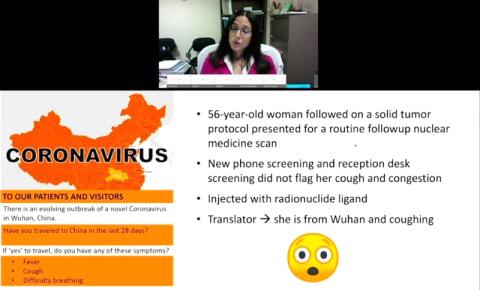Gloves Off
As in Hospitals, So in Homes: Avoiding Coronavirus Infection

The take-home messages—let’s call them stay-at-home messages—came fast and thick during Clinical Center epidemiologist Dr. Tara Palmore’s May 20 lecture on how NIH’s hospital first became aware of a rising threat from a novel coronavirus, then took steps to keep it not quite out of the CC, but away from patients, none of whom, so far, have been infected by staff.
“It is impossible to overstate how crucial Tara Palmore and her staff have been in preventing the spread of Covid-19,” said Dr. James Gilman, CEO of the Clinical Center. He introduced her detective story—part of a new lecture series by the Covid-19 scientific interest group—on a day when the CC had screened its 100,000th visitor.
“That’s an astonishing number,” he said. “But we followed the playbook written by Tara Palmore. The virus has slipped in once or twice, and we were able to do contact-tracing later [18 contact studies over 9 weeks turned up 4 cases of secondary infection of staff by patients or other staff, some of whom, in mid-March, were not yet wearing masks].” Gilman praised Palmore’s “kindness, understanding and patience, especially with employees who were worried about bringing the virus home.”
After thanking a Hospital Epidemiology Service (HES) staff she called “amazing” (including its former head, Dr. David Henderson, who semi-retired 5 months ago), Palmore embarked on what she called the CC’s “quirky timeline with Covid-19,” beginning on New Year’s Eve, when “vague news of undiagnosed pneumonia in Wuhan reached us, involving a few dozen people.”
Ten days later, the new virus’s sequence was posted, and on Jan. 22, the Clinical Center began screening patients by travel history, with recent sojourns in China being of particular concern.
“Each day seemed like an eternity,” she said, as employees screened all patients either in clinic or by phone.
On Jan. 27, posters went up throughout the CC, warning of signs and symptoms. That day, a call came in that produced alarm. Down in the nuclear medicine department, a 56-year-old cancer patient, who had already been injected with a radionuclide for her procedure, began coughing. She also had a fever and difficulty breathing.
A translator on hand confirmed that she was from Wuhan and was suffering symptoms not flagged earlier by staff.
“There had been one or two travel-related cases” in the United States of a suspected disease not yet called covid, Palmore said, but no cases at the Clinical Center.
“We raced down to nuclear medicine and found the chief technician there, calm as a cucumber,” she said. They had brought personal protective equipment (PPE) for both the technician and the translator and had already “garbed up” themselves.
A nasopharyngeal swab from the patient was taken to the CC microbiology lab, where it tested positive for respiratory syncytial virus (RSV). Palmore sought advice from the Maryland health department. The queue to reach the CDC by phone was 6 hours long. The health department advised that, given the positive RSV test, the patient be sent home in a mask to self-isolate without further testing.
“The patient did just fine, and recovered from her RSV,” recounted Palmore. “We wiped the sweat off our brows and continued our work, but [the episode] galvanized us into action. From that point on, we began holding weekly, then daily, then thrice daily meetings.”
On Mar. 5, the first cases of Covid-19 were reported in Maryland. On Mar. 14, the first known NIH employee was diagnosed. On Mar. 24, the first patient was admitted to the CC, on an NIAID protocol involving the antiviral remdesivir.
As of May 20, 8 patients had been transferred to the CC for Covid-19 clinical trials. Some 292 tests on 199 patients had been conducted, 10 of which came back positive. The Occupational Medical Service counted 171 cases among employees, 14 percent of whom were clinical personnel. More than 1.5 million cases had been reported in the U.S., with more than 90,000 deaths. “Both numbers are probably low,” said Palmore.
“We’re gonna be in this for months,” she said. “We have to be prepared for the current level of risk for the long haul.”
Palmore paused to point out that studies of epidemiology curves of Covid-19 infection in Italy and China, as well as data from earlier coronavirus outbreaks due to SARS-CoV and MERS-CoV, have reported occupational infection rates for health care workers of about 20 percent.
“So there is significant occupational risk,” she said. “Every day, we are confronted with new scientific findings…[that] make us not want to leave our house, or our bedroom.”

For example, NIDDK scientists showed that speech itself produces droplets that can persist for 8-14 minutes in the air of a closed space, as demonstrated through tracking with a green laser. The very smallest particles, called an aerosol, can persist longer. “That’s unsettling,” said Palmore.
At an MIT lab, researchers showed that the gas cloud produced by sneezing can travel 7-8 meters almost instantly.
“Living with a husband and three teenage boys, I did not need a scientific study to know that sneezes can travel that far,” Palmore quipped.
Researchers at NIAID’s Rocky Mountain Laboratories showed that SARS-CoV-2 can survive for up to 72 hours on stainless steel and plastic.
“The headlines, too, can be unsettling,” added Palmore, offering as examples: Do masks work? Is hoarding them wrong? Should people wear them in public?
HES, too, got inquiries: Who is really protected by surgical masks?
Originally made of cotton, surgical masks were invented more than a century ago, said Palmore. While cotton is still used in some parts of the world, most masks nowadays are made of a fluid-resistant polypropylene fabric. Their job was originally to protect patients from the oral flora of surgeons. Studies going back to hospital care in 1918 showed they could prevent spread of diphtheria, meningitis and pneumonia to health care personnel.
Today, masks mainly protect others from whatever bug the mask-wearer may be carrying. They can also protect the wearer from other peoples’ pathogens, Palmore explained. But when particles can range in size from droplets (5-10 micrometers) to less than 5 micrometers (aerosols), how fine a mask is appropriate in which setting?
The CDC currently recommends N95 masks for health care workers encountering Covid-19 patients, and for any medical procedure likely to generate aerosols. In the absence of such masks, surgical masks are used, which is the case in many parts of the country lacking adequate PPE.
Caregivers at the CC use N95 masks, fitted tightly, and sometimes PAPR—powered air-purifying respirators, which are battery-powered generators of positive air pressure, fitted with HEPA filters, for care of patients with Covid-19. “They’re uncomfortable, but they work,” noted Palmore.
“Eye protection is also important for any respiratory viral infection,” she said, though “face shields are not a substitute” for masks in avoiding such infections.
“This is a cruel virus,” she reminded the audience. “It is unforgiving and it wreaks havoc in the human body.”

Fortunately, SARS-CoV-2 is an enveloped virus and is easily inactivated in the environment by soap and water, Palmore said. Viruses such as norovirus, which have no envelope, require stronger measures for environmental disinfection, such as bleach.
“A bottle of 409 from under the kitchen counter will take care of [SARS-CoV-2], or disinfectant wipes,” said Palmore, emphasizing that “hand hygiene is critical for all viruses.”
It may come as a surprise to learn that wearing gloves—“often seen around the Clinical Center, and on campus, the Metro and in stores—is not a solution to the problem of environmental contamination,” said Palmore. “It makes it worse. All it does is act as a dirty layer of skin over your own skin. It just takes an environmental contaminant and moves it around. It makes everything dirtier for everyone else.”
When barrier protection and hand-washing fail and a person becomes infected, contact-tracing begins, of anyone an infected individual encountered 2-3 days before noticing symptoms. It is thought that peak viral load occurs in the upper respiratory tract at the time of symptom onset.
This scenario unfolded as Apr. 30 became May 1 in the CC. A woman, 47, in remission from a blood cancer, who had swabbed negative for Covid-19 9 days prior to admission, had fever on admission, a high heart rate, low oxygen (93 percent, when it should have been over 95) and looked ill. She coughed incessantly and seemed tired.
Second and third swabs were negative. A chest X-ray revealed bilateral pneumonia. A CT scan also was “very bad looking.”
A bronchoscopy was scheduled and a bronchoalveolar lavage later revealed Covid-19 infection.
“That prompted a massive contact study of more than 75 people,” said Palmore, including staff who had merely been in contact with bed linens. Thirty had high-risk exposures and were immediately home-quarantined. Thirty-eight had low-risk exposures and continued to work with masks on. After 14 days, none turned out to be infected, “which was really a miracle,” said Palmore. “We learned a lot of lessons from that incident and we made some improvements to our infection control as a result.”
The day after Palmore’s talk, the Clinical Center instituted testing of asymptomatic staff who have patient contact.
Infection prevention involves a hierarchy of controls, she concluded, including administrative (symptom screening, social distancing, rotating care teams and testing), engineering (negative-pressure wards, a special operating room for procedures that generate aerosols) and PPE.
“We are continually re-evaluating and improving our methods, based on new science and on feedback,” she said.
During a Q&A session, Palmore clarified a number of issues.
- Asked if people should wipe down all packages that enter their homes, she said, “I don’t do that myself. I wash my hands and try to use common sense. People are worried about cardboard, mail, grocery items. I don’t believe the virus lasts long enough for special concern on any of these.”
- If you use cloth masks, “the more layers, the more useful it’s likely to be…The thicker, the better, so double up.”
- If you use hand sanitizer, cover all surfaces and let the gel evaporate. “That’s very important,” said Palmore. “Don’t wipe it off on anything.”
- The same goes for disinfectant wipes. “Don’t dry surfaces afterward with a paper towel. Allow dwell time. Leave it wet and allow it to air dry.”
The full lecture is available at https://videocast.nih.gov/watch=37499.
